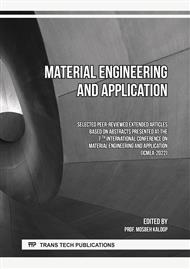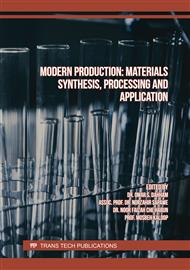[1]
Day, D., Lancaster, I. M., & McKay, D. (2019). Emulsion cold mix asphalt in the UK: A decade of site and laboratory experience. Journal of Traffic and Transportation Engineering (English Edition), 6(4), 359-365 https://doi.org/10.1016/j.jtte.2019.05.002.
DOI: 10.1016/j.jtte.2019.05.002
Google Scholar
[2]
Eller, A., & Olson, R. (2009). Recycled pavements using foamed asphalt in Minnesota (No. MN/RC 2009-09). Minnesota departement of transportation, Maplewood, MN.
Google Scholar
[3]
Construction and Planning Agency Ministry of the Interior Taiwan CPAMI, 31 10 2019. [Online]. Available: cpami.gov.tw. [Accessed 10 7 2021].
Google Scholar
[4]
Saleh, A., & Gáspár, L. (2021). Advantages and limitations of using foamed bitumen. Acta Technica Jaurinensis https://doi.org/10.14513/actatechjaur.00587, (2021).
DOI: 10.14513/actatechjaur.00587
Google Scholar
[5]
Huang, M., Chen, H., Shi, X., & Wen, X. (2021). Foaming effect influence of PBT/ABS resin as a reducing agent in foamed asphalt. In IOP Conference Series: Materials Science and Engineering. IOP Publishing. Sanya, China Vol. 1028, No. 1, p.012010 https://doi.org/10.1088/1757-899X/1028/1/012010.
DOI: 10.1088/1757-899x/1028/1/012010
Google Scholar
[6]
Ojum, C., & Thom, N. (2017). Effect of binder in recycled asphalt on cold-mix pavements. Proceedings of the Institution of Civil Engineers-Construction Materials, 170(4), 205-210 https://doi.org/10.1680/jcoma.16.00038.
DOI: 10.1680/jcoma.16.00038
Google Scholar
[7]
Mugume, R. B. (2021). Investigation of Foamed Bitumen Mixes Using Reclaimed Asphalt Pavement Materials for Cold Recycling Technology. International Journal of Pavement Research and Technology, 1-13 https://doi.org/10.1007/s42947-021-00014-4.
DOI: 10.1007/s42947-021-00014-4
Google Scholar
[8]
Xiao, F., Hou, X., Amirkhanian, S., & Kim, K. W. (2016). Superpave evaluation of higher RAP contents using WMA technologies. Construction and Building Materials, 112, 1080-1087 https://doi.org/10.1016/j.conbuildmat.2016.03.024.
DOI: 10.1016/j.conbuildmat.2016.03.024
Google Scholar
[9]
Jenkins, K. J. (2000). Mix design considerations for cold and half-warm bituminous mixes with emphasis of foamed bitumen (Doctoral dissertation, Stellenbosch: Stellenbosch University).
Google Scholar
[10]
Hasan, M. R. M., You, Z., Yin, H., You, L., & Zhang, R. (2019). Characterizations of foamed asphalt binders prepared using combinations of physical and chemical foaming agents. Construction and Building Materials, 204, 94-104 https://doi.org/10.1016/j.conbuildmat. 2019.01.156.
DOI: 10.1016/j.conbuildmat.2019.01.156
Google Scholar
[11]
Bairgi, B. K., & Tarefder, R. A. (2017). A synthesis of asphalt foaming parameters and their association in foamed binder and mixture characteristics. In Airfield and Highway Pavements 2017 (pp.256-267) https://doi.org/10.1061/9780784480939.023.
DOI: 10.1061/9780784480939.023
Google Scholar
[12]
Wirtgen (2010). Cold Recycling. Wirtgen cold recycling technology. Wirtgen, Germany.
Google Scholar
[13]
Ozturk, H. I., & Kutay, M. E. (2014). Effect of foamed binder characteristics on warm mix asphalt (WMA) performance (No. 14-3953).
Google Scholar
[14]
Jenkins, K. J., Van de Ven, M. F. C., & De Groot, J. L. A. (1999, August). Characterisation of foamed bitumen. In 7th Conference on asphalt pavements for Southern Africa (Vol. 18).
Google Scholar
[15]
K Kar, S. S., Swamy, A. K., Tiwari, D., & Jain, P. K. (2020). Impact of Chemical Composition on Foaming Characteristics of Asphalt Binder. Journal of Transportation Engineering, Part B: Pavements, 146(3), 04020045 https://doi.org/10.1061/JPEODX.0000196.
DOI: 10.1061/jpeodx.0000196
Google Scholar
[16]
Newcomb, D. E., Arambula, E., Yin, F., Zhang, J., Bhasin, A., Li, W., & Arega, Z. (2015). Properties of foamed asphalt for warm mix asphalt applications (No. Project 09-53).
DOI: 10.17226/22145
Google Scholar
[17]
Hailesilassie, B. W., Hugener, M., & Partl, M. N. (2015). Influence of foaming water content on foam asphalt mixtures. Construction and Building Materials, 85, 65-77 https://doi.org/10.1016/j.conbuildmat.2015.03.071.
DOI: 10.1016/j.conbuildmat.2015.03.071
Google Scholar
[18]
Saleh, M. F. (2007). Effect of rheology on the bitumen foamability and mechanical properties of foam bitumen stabilised mixes. International Journal of Pavement Engineering, 8(2), 99-110 https://doi.org/10.1080/10298430601149650.
DOI: 10.1080/10298430601149650
Google Scholar
[19]
Ozturk, H. I., & Kutay, M. E. (2014). Sensitivity of nozzle-based foamed asphalt binder characteristics to foaming parameters. Transportation Research Record, 2444(1), 120-129 https://doi.org/10.3141/2444-14.
DOI: 10.3141/2444-14
Google Scholar
[20]
Holý, M., & Remišová, E. (2019). Analysis of influence of bitumen composition on the properties represented by empirical and viscosity test. Transportation Research Procedia, 40, 34-41 https://doi.org/10.1016/j.trpro.2019.07.007.
DOI: 10.1016/j.trpro.2019.07.007
Google Scholar
[21]
Carrera, V., García-Morales, M., Navarro, F. J., Partal, P., & Gallegos, C. (2010). Bitumen chemical foaming for asphalt paving applications. Industrial & engineering chemistry research, 49(18), 8538-8543 https://doi.org/10.1021/ie101136f, (2010).
DOI: 10.1021/ie101136f
Google Scholar
[22]
Mangiafico, S., Di Benedetto, H., Sauzéat, C., Olard, F., Pouget, S., & Planque, L. (2016). Relations between linear ViscoElastic behaviour of bituminous mixtures containing reclaimed asphalt pavement and colloidal structure of corresponding binder blends. Procedia engineering, 143, 138-145 https://doi.org/10.1016/j.proeng.2016.06.018.
DOI: 10.1016/j.proeng.2016.06.018
Google Scholar
[23]
Lesueur, D. (2009). The colloidal structure of bitumen: Consequences on the rheology and on the mechanisms of bitumen modification. Advances in colloid and interface science, 145(1-2), 42-82 https://doi.org/10.1016/j.cis.2008.08.011.
DOI: 10.1016/j.cis.2008.08.011
Google Scholar
[24]
Yang, C., Xie, J., Wu, S., Amirkhanian, S., Zhou, X., Ye, Q., ... & Hu, R. (2020). Investigation of physicochemical and rheological properties of SARA components separated from bitumen. Construction and Building Materials, 235, 117437 https://doi.org/10.1016/j.conbuildmat. 2019.117437.
DOI: 10.1016/j.conbuildmat.2019.117437
Google Scholar
[25]
Gaestel, C., Smadja, R., & Lamminan, K. A. (1971). Contribution à la connaissance des propriétés des bitumes routiers. Rev. Gentile. Routes et Aérodromes, 466, 85-94.
Google Scholar
[26]
Ashoori, S., Sharifi, M., Masoumi, M., & Salehi, M. M. (2017). The relationship between SARA fractions and crude oil stability. Egyptian Journal of Petroleum, 26(1), 209-213 https://doi.org/10.1016/j.ejpe.2016.04.002.
DOI: 10.1016/j.ejpe.2016.04.002
Google Scholar
[27]
Weigel, S., & Stephan, D. (2018). Relationships between the chemistry and the physical properties of bitumen. Road Materials and Pavement Design, 19(7), 1636-1650 https://doi.org/10.1080/14680629.2017.1338189.
DOI: 10.1080/14680629.2017.1338189
Google Scholar
[28]
Lambert, M., Piau, J. M., Gaudefroy, V., Millien, A., Dubois, F., Petit, C., & Chaignon, F. (2018). Modeling of cold mix asphalt evolutive behaviour based on nonlinear viscoelastic spectral decomposition. Construction and Building Materials, 173, 403-410 https://doi.org/10.1016/j.conbuildmat.2018.03.207.
DOI: 10.1016/j.conbuildmat.2018.03.207
Google Scholar
[29]
Jiang, C., Larter, S. R., Noke, K. J., & Snowdon, L. R. (2008). TLC–FID (Iatroscan) analysis of heavy oil and tar sand samples. Organic Geochemistry, 39(8), 1210-1214 https://doi.org/10.1016/j.orggeochem.2008.01.013.
DOI: 10.1016/j.orggeochem.2008.01.013
Google Scholar
[30]
Eleyedath, A., Kar, S. S., & Swamy, A. K. (2021). Modelling of expansion ratio and half-life of foamed bitumen using gene expression programming. International Journal of Pavement Engineering, 22(3), 369-381 https://doi.org/10.1080/10298436.2019.1609675.
DOI: 10.1080/10298436.2019.1609675
Google Scholar
[31]
Asphalt Academy. (2009). Technical guideline: Bitumen stabilised materials. A guide for the design and construction of bitumen emulsion and foamed bitumen stabilised materials.
DOI: 10.1201/9780203092989.ch112
Google Scholar
[32]
MathWorks,MatlabR2019a".Available:https://www.mathworks.com/products.html,s_tid=gn_ps.
Google Scholar
[33]
IBM, SPSS Statistic 22.0,, IBM, Available: www.ibm.com.
Google Scholar



